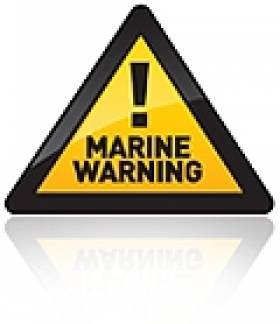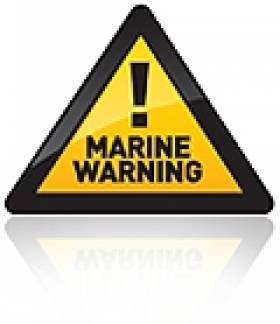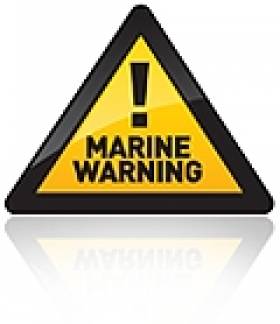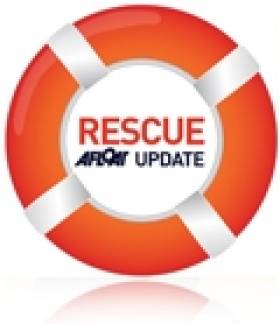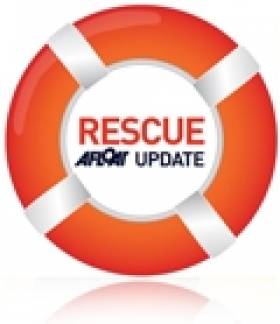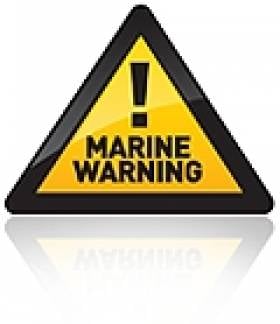Displaying items by tag: marine warning
New Marine Notices on Small Vessel Safety
#MARINE WARNING - Two recent Marine Notices from the Department of Transport, Tourism and Sport (DTTAS) highlight the safety recommendations made in reports by the Marine Casualty Investigation Board (MCIB) earlier this year into separate small vessel accidents, one of which resulted in the death of two fishermen.
Marine Notice No 39 of 2012 details recommendations from the report into the Lady Linda tragedy off the coast of Skerries in North Dublin in April last year, which cost the lives of 26-year-old Ronan Browne and 41-year-old David Gilsenan.
In its investigation, the MCIB noted a number of contributary factors to the incident, such as weather conditions and wave height, the absence of lifejackets and the inaccessibility of emergency equipment.
The DTTAS is urging all fishermen to check weather conditions before any voyage and ensure that their vessel can cope with them safety. It also reiterates the legal obligation for fishermen to wear suitable personal flotation devices while on deck, and that the carriage of an EPIRB distress becaon is mandatory for all fishing vessels.
Meanwhile, Marine Notice No 40 of 2012 concerns the carriage of livestock aboard small vessels, after an incident on the MV Claire Buoyant off Beginish Island in Co Kerry in August a year ago that led to a cargo of 21 sheep being jettisoned overboard.
The MCIB report reminded that any vessel carrying livestock must be appropriately certified due to the dangers involved in transporting live cargo. It also recommended that such vessels develop a regular maintenance regime to check all fittings that are open to the sea, and to ensure that bilge pumps are free from blockage.
#MARINE WARNING - A small craft weather warning is in effect today as strong easterly winds bring heavy rains sweeping across Ireland.
Met Éireann reports that strong gales between force 5 and 6 are developing this morning on all coasts and on the Irish Sea, with northerly gales set to develop on western and southern coasts this afternoon, and speeds in most places expected to reach force 8 or 9.
Winds may even reach storm force 10 between Roche's Point and Slyne Head by the end of the day.
In addition, Irish Coast Guard manager Declan Geoghegan told the Press Association that local flooding is likely throughout the country - especially in Connacht, which may experience up to 60mm of rainfall - and warned the public not to attempt crossing fast-running rivers or fords.
“The combination of tides, forecasted high winds in the coming days and swollen rivers may result in very dangerous conditions," he said.
The Irish Times has more on the story HERE.
Monday's Full Moon Poses Hazard to Beach Goers
#FULLMOON – Hazards that result in drowning are often the last thought in the minds of people relaxing over a Bank Holiday weekend however Irish Water Safety is anxious that the public avoid situations that can quickly turn to tragedy such as stranding when walking shorelines. IWS is also calling for people to use Lifeguarded waterways this Bank Holiday weekend.
Monday's full moon will bring higher and lower tides resulting in deeper waters at high tide and more exposed shoreline at low tide. Walkers should therefore enjoy with caution coastal walks and avoid being stranded by incoming tides.
Irish Water Safety trained Lifeguards, employed by Local Authorities, will begin patrolling our waterways this weekend to protect the public from dangers such as rip currents and strong surf. Directions to all lifeguarded bathing places are available at http://www.iws.ie/bathing-areas-page.html Having Irish Water Safety Lifeguards nearby is reassuring in case you need advice, help with first aid or missing children. They are trained to prevent or react to unexpected incidents where seconds can make a difference. However, Lifeguards are not a babysitting service and members of the public have a duty of care to protect themselves and their families when visiting waterways nationwide.
Wind Farm Rock Berms Pose a Hazard for Boaters Says RYA
#MARINE WARNING - As wind farm projects expand around the coasts of the UK and Ireland, the Royal Yachting Association (RYA) has raised concerns about an unexpected hazard for boaters navigating near such installations.
Taking the London Array and Kentish Flats wind farm areas in South East England as a case study, the RYA explains how rock placements, or rock berms, have been put in place to protect the power cables from these arrays at the points where they cross in shallow water.
The RYA warns that as cable crossing become more likely and more frequent, as offshore energy projects expand around the coastline, the potential for accidents is greatly increased.
"It is this cable protection that in shallow waters can reduce underwater clearance and therefore pose a risk to navigational safety," said the RYA.
Referring to the London Array and Kentish Flats specifically, the association said it "was not aware that the cables would have rock protection until we received a notice.
"It would seem that the Marine Management Organisation, Trinity House and the Maritime and Coastguard Agency were also unaware that the developers were placing a rock berm in [the[ area and are investigating how all this happened 'sight unseen' - particularly as it seemed that the original London Array Limited applications had stated that the cables would be trenched."
The RYA has more on the story HERE.
#MARINE WARNING - The latest Marine Notice from the Department of Transport, Tourism and Sport (DTTAS) advises on cable laying operations in the Irish Sea commencing today 22 April.
Following preliminary work on the East-West Interconnector power cable earlier this month, as previously reported on Afloat.ie, cable laying works will be undertaken by AMC Connector (call sign LAKY7) for a duration of approximately 18 days, subject to weather delays.
Operations will involve deployment of cable and ROVs which will restrict the vessel’s ability to manoeuvre.
The vessel will operate on a 24-hour basis, displaying appropriate day shapes and lights during operations, and will transmit an AIS signal. The vessel will be keeping a listening watch on VHF Channel 16 at all times during the operations.
All vessels, particularly those engaged in fishing, are requested to give the AMC Connector a wide berth.
Complete details including co-ordinates of the work area are included in Marine Notice No 20 of 2012, a PDF of which is available to read and download HERE.
Second Cruiser in a Week Runs Aground in Lough Erne
#RESCUE - Four people were rescued on Lough Erne yesterday after their motor cruiser ran aground in the second such incident in a week, the Belfast Telegraph reports.
All on board were retrieved by RNLI lifeboat from the 29ft cruiser, which is believed to have stranded on rocks beyond the marked channel of the lough.
No injuries or damage to the vessel were reported, with a Northern Ireland Coastguard spokesperson describing it as "a routine rescue".
The coastguard blamed low water levels in the lough caused by lack of rainfall in Co Fermanagh.
Waterways Ireland has posted a marine notice warning boat users of the risks posed by "the extended period of unseasonal dry weather" for Ireland's inland waterways.
In a similar incident last Friday, three adults and two children were rescued from a cruiser that stranded in shallow water on the lough.
The Belfast Telegraph has more on the story HERE.
Marine Notice: East-West Interconnector Works in Irish Sea
#MARINE WARNING - The latest Marine Notice from the Department of Transport, Tourism and Sport (DTTAS) advises on preliminary work on the East-West interconnector power cable in the Irish Sea between Ireland and Wales over the next few weeks.
Briggs Marine commenced pre-lay grapnel runs along the line of the cable route on Sunday 1 April, and this work will be carried out over three weeks from the vessel Kingdom of Fife (call sign 2BKR2).
This work will continue on a 24-hour basis, and the vessel will display appropriate day shapes and lights as required, with a continuous watch on VHF Channel 16 and DSC.
Complete details including co-ordinates of the work area are included in Marine Notice No 14 of 2012, a PDF of which is available to read and download HERE.
High Tides increase Easter Drowning Risk Warns Safety Body
Thousands of people will enjoy Easter bank holiday breaks on or close to waterways that pose a danger if safety is not heeded especially as there will be a Full Moon and some of the highest tides of the year. Irish Water Safety is pleading with the public to avoid tragedy by supervising children on holidays and exercising common sense around our shorelines, rivers and lakes.
Children are attracted to water but can drown silently in seconds. It is critical that adults supervise children at all times. Visitors to rural homes should ensure that children do not stray alone to septic tanks, quarries or riverbanks.
Those boating over the holiday weekend will share their enthusiasm with swimmers, divers, anglers, canoeists, surfers and thousands more walking the shoreline. Walkers and shellfish pickers should be aware of the dangers of stranding posed by the spring tides. Those enjoying what is commonly their first boating trip of 2012 should ensure that every person on board wears a correctly fitting well maintained lifejacket with crotch strap.
Cold-water temperatures are close to ten degrees at present. Most swimmers will not yet be acclimatized to such conditions and should not stay too long in open water.
Alcohol is a contributory factor in approximately one-third of all drownings, therefore alcohol should not be consumed before or during aquatic activities.
If you have not used your lifejacket since last year then you will need to carry out the following checks.
Visually Check all lifejackets and buoyancy aids for the following deficiencies:
Ensure CO2 Cartridges have not been punctured
Ensure all zips, buckles, fasteners and webbing straps are functioning correctly
Check that fitted lights are operating correctly
Check that the valve or lifejacket is not leaking by inflating the lifejacket overnight or immersing it in water checking for air bubbles
Discard any faulty lifejackets by destroying them
Always use your crotch strap when fitting your lifejacket
Emergencies
If you see someone in difficulty in the water dial 999 OR 112. Don't assume someone else will make the call.
For water safety information for children www.aquaattack.ie
Angler Dies After Lough Corrib Incident
#RESCUE - One angler has died in hospital and another was receiving emergency treatment last night after their boat got into difficulty on Lough Corrib.
According to The Irish Times, the two men were among a party of three on a boat that was struck by a wave off Annaghdown, which knocked one of them into the water.
Though he was reportedly wearing a lifejacket before he went overboard, an empty jacket was then spotted floating on the surface. One colleague entered the water to search for him but was unsuccessful.
Responding to the distress call from a nearby angling boat, the Irish Coast Guard's Shannon helicopter located the missing angler soon after arriving on scene, some 50 minutes after he entered the water.
The man was airlifted to University Hospital Galway, with the coastguard chopper returning for his colleague when he showed signs of hypothermia.
A small craft warning from Met Éireann was in effect throughout the area at the time of the incident.
The Irish Times has more on the story HERE.
Marine Notice: Rock Placement Offshore at Rush Beach
#MARINE NOTICE - The latest Marine Notice from the Department of Transport, Tourism and Sport (DTTAS) advises on rock placement operations offshore at North Beach in Rush, Co Dublin and in the Irish Sea.
Works commenced on 19 January to continue for around 14 days, subject to weather delays, undertaken by DPFPV Tideway Rollingstone (call sign PHYR) which is operating on a 24-hour basis.
The vessel is transmitting an AIS signal and will be keeping a listening watch on VHF Channel 16 at all times. It is also displaying appropriate day shapes and lights.
The works - which involve the deployment of survey ROV and fall pipe - will restrict the vessel's ability to manoeuvre, so all vessels in the vicinity (particular fishing boats) have been given warning to give the vessel and her equipment a wide berth.
Complete details including co-ordinates of work areas are included in Marine Notice No 4 of 2012, a PDF of which is available to read and download HERE.


























